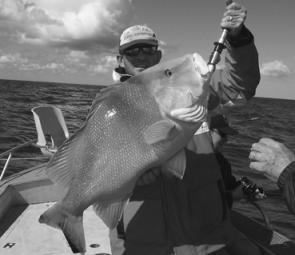The northern beaches and more importantly the small shoals and bombies just offshore have been overrun by doggie mackerel.
More traditional areas such as the alligator weedbeds or the shipping channel markers have yet to fire with good numbers of our bread and butter mackerel. However, a small feed can still be caught. Keen anglers willing to be on the water before dawn using a combination of berley, lightly weighted pilchards or even suspended under floats should snare a greedy doggie.
As the sun rises you may find the fish shutting down, this can be the perfect time to use small metal slices at high speed – doggies find this presentation irresistible. Remember that you can’t wind fast enough, even if it looks like the lure got away from the fish nine times out of ten, the lure was not going fast enough for them. This is because they hunt by using speed to run down their prey; we are trying to make a piece of metal look like a baitfish trying to escape.
Some of the best areas to try this month will be any of the country inside Halifax Bay such as Paluma Shoals, Crystal Creek and Burdekin Rocks, basically any structure between West Point and Taylors Beach should hold doggies this month.
The same techniques can be used offshore for their larger cousins the Spanish mackerel. Shoals, wrecks and bombies are great places to find Spaniards at this time of the year. Most anglers will float a pillie out under a balloon while bottom bouncing for reds. While this will work it isn’t the best method of targeting big mackerel.
As with the smaller mackerel species speed is a key ingredient whether you are trolling, drifting or high speed spinning lures or bait. Spinning or jigging has gained popularity in recent years thanks to the mainstream media and increasing availability of specialist tackle. This makes retrieving speeds that are required to entice strikes easier for the average fisherman to reach without having arms like a body builder.
Trolling is probably the most popular method of catching big mackerel because we can use larger baits and lures that don’t require casting. This way we cover a lot more ground and our lines are always in the water.
One of the best things about bluewater trolling is the by-catch, which includes cobia, wahoo or even small black marlin.
A large number of big red emperor have been caught this season as well as large mouth nannygai. Try to limit your catch so they are still there for next time – very few people are impressed by stories of wholesale slaughter, which is a good thing.
Closer to home the local beaches have been firing with big winter whiting, bream and flathead. Cungulla Beach to the south of town has been the most productive of late with the bigger fish coming from the Salmon Creek end of the beach.
The Haughton River also south of town has been the best as far as barramundi captures go this month. Bait has been a little hit and miss in this system and as a result most of the regular barra boys have been catching their prawns elsewhere and transporting them alive.
Remember that during winter barra won’t actively hunt so you have to put your baits as close as possible to the fish, which is where your sounder will really comes in to its own. Learn to read what’s on the screen and you will start to catch more fish whether your in the creek or out to sea.
Reads: 4045
Markus Cox with a nice black kingfish taken chasing mackerel around Magnetic Island.

School-sized Spanish mackerel like this will be about in big numbers off Townsville in August.

Troy Jones with a great red emperor taken out from Townsville.




